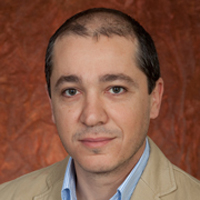
Department of Biomedical
Sciences at Florida State.
Three years after discovering that a single, unidentified mechanism was modifying about 800 proteins simultaneously during cell division, Florida State University researchers have identified that mystery enzyme.
It’s TOPK, an enzyme that belongs to the family of protein kinases — which orchestrate much of the networking and signaling in cells. The discovery, led by College of Medicine researcher Raed Rizkallah in the Department of Biomedical Sciences, is significant because it advances our understanding of cell division and could lead to therapies that pinpoint cancerous cells without destroying healthy ones.
“This is a very promising target for cancer treatment,” said Myra Hurt, senior associate dean of the College of Medicine. “Some of the new generation of cancer drugs are kinase inhibitors.”
Rizkallah, who works with Hurt, also collaborated with the medical school’s Translational Science Laboratory and FSU’s Department of Chemistry and Biochemistry. The paper appeared in the online edition of Oncotarget, a specialized journal that publishes cancer-related research.
Other researchers had detected TOPK at high levels in many types of cancer, but Rizkallah is the first to identify its functional significance to dividing cells.
Proteins are the workhorses in cells, according to Rizkallah.
“Some continuously interact with the DNA, but not during that stage where cells are dividing. Something makes them back off — an enzyme or enzymes,” he said. “The shutting down of gene expression during cell division has been known for a long time, but people haven’t fully understood all its underlying mechanisms.”
So it was a challenge to learn the identity of this “master mitotic regulator” that can modify such a large family of proteins at the same time. Rizkallah used a fishing analogy to describe his work.
“We had the fish: Enzyme X,” he said. “We had the bait” — a molecule that the Hurt lab had found to attract the enzyme. “But it wasn’t on a hook, so we couldn’t pull out Enzyme X to examine and identify it. A chemical modification by chemistry Associate Professor Greg Dudley and his graduate student helped us put a hook in it.”
Next, he needed the cutting-edge help of the mass spectrometer in the Translational Science Lab, which analyzed exactly what was in the purified complexes. Then Rizkallah went down a list of 40 to 50 candidate proteins, comparing each one with what he knew about Enzyme X. Finally, he concluded that Enzyme X was actually TOPK. Now he’s following up on how TOPK is activated and how it’s regulated in cancer cells.
“Working with Raed has been extremely satisfying for graduate student Paratchata Batsomboon and me,” Dudley said. “It’s one thing to think that the chemistry we develop can impact biomedical research in due course. It’s quite another to know that the fruits of our chemistry labor are going directly into biomedical experiments across campus. Intercollege collaboration adds value to both programs.”




